The global HVDC transmission system market is valued at USD 22.9 billion in 2025 and is slated to reach USD 64.4 billion by 2035, recording an absolute increase of USD 41.5 billion over the forecast period. This translates into a total growth of 181.2%, with the market forecast to expand at a compound annual growth rate (CAGR) of 10.9% between 2025 and 2035. The overall market size is expected to grow by nearly 2.8X during the same period, supported by increasing demand for efficient long-distance power transmission, growing adoption of renewable energy integration, and rising preference for grid modernization across diverse energy applications.
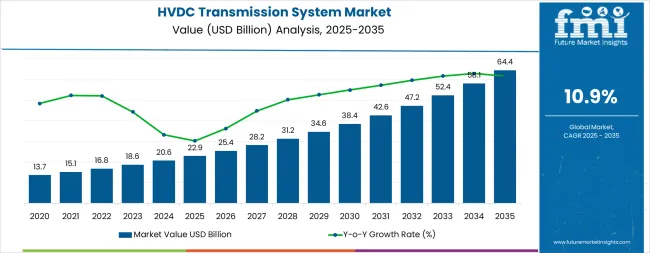
Between 2025 and 2030, the HVDC transmission system market is projected to expand from USD 22.9 billion to USD 38.1 billion, resulting in a value increase of USD 15.2 billion, which represents 36.6% of the total forecast growth for the decade. This phase of development will be shaped by increasing renewable energy integration expansion, rising adoption of advanced converter technologies, and growing demand for grid interconnection solutions in cross-border power transmission. Energy utilities are expanding their HVDC system sourcing capabilities to address the growing demand for efficient power transmission solutions and enhanced grid stability.
| Metric | Value |
|---|---|
| Estimated Value in (2025E) | USD 22.9 billion |
| Forecast Value in (2035F) | USD 64.4 billion |
| Forecast CAGR (2025 to 2035) | 10.9% |
From 2030 to 2035, the market is forecast to grow from USD 38.1 billion to USD 64.4 billion, adding another USD 26.3 billion, which constitutes 63.4% of the overall ten-year expansion. This period is expected to be characterized by the expansion of ultra-high voltage (UHV) and voltage source converter technologies, the integration of digital twin monitoring solutions, and the development of subsea HVDC transmission systems for offshore renewable energy projects. The growing adoption of net-zero emission targets and cross-border energy trading will drive demand for HVDC systems with enhanced power transfer capabilities and minimal transmission losses.
Between 2020 and 2025, the HVDC transmission system market experienced robust growth, driven by increasing utility demand for efficient power transmission solutions and growing recognition of HVDC systems as essential infrastructure for renewable energy integration with enhanced grid stability. The market developed as energy utilities recognized the potential for HVDC systems to reduce transmission losses while supporting long-distance power transfer and grid interconnection requirements. Technological advancement in converter technologies and deployment methods began emphasizing the critical importance of maintaining power quality and grid reliability in modern transmission infrastructure.
Market expansion is being supported by the increasing global demand for efficient power transmission and the corresponding need for grid infrastructure that can maintain power quality and reliability while supporting renewable energy integration across various transmission applications. Modern energy utilities are increasingly focused on implementing transmission solutions that can reduce power losses, minimize environmental impact, and provide consistent performance in long-distance power transfer. HVDC systems' proven ability to deliver enhanced transmission efficiency, reduced losses, and versatile grid interconnection capabilities make them essential infrastructure for contemporary power transmission and grid modernization solutions.
The growing emphasis on renewable energy integration and grid stability is driving demand for HVDC systems that can support offshore wind farms, reduce transmission costs, and enable efficient power transfer across vast distances. Energy utilities' preference for transmission infrastructure that combines high efficiency with operational reliability and cost-effectiveness is creating opportunities for innovative HVDC system implementations. The rising influence of energy security concerns and grid modernization demands is also contributing to increased adoption of HVDC systems that can provide stable transmission solutions without compromising power quality or grid reliability.
The HVDC transmission system market is poised for rapid growth and transformation. As utilities across both developed and emerging markets seek transmission infrastructure that is efficient, reliable, stable, and sustainable, HVDC systems are gaining prominence not just as alternatives to AC transmission but as strategic infrastructure for renewable energy integration, cross-border power trading, grid modernization, and offshore wind connections.
Rising electricity demand and renewable energy deployment in South Asia & Pacific, East Asia, North America amplify demand, while manufacturers are picking up on innovations in converter technologies and deployment improvements.
Pathways like subsea deployment, ultra-high voltage systems, and digital monitoring promise strong margin uplift, especially in mature markets. Geographic expansion and localization will capture volume, particularly where renewable energy integration is prioritized or grid infrastructure requires modernization. Regulatory pressures around energy security, grid stability, emission reduction, and renewable energy integration give structural support.
The market is segmented by system, deployment, application, and region. By system, the market is divided into HVDC transmission products and HVDC transmission services. By deployment, it covers overhead, underground, and subsea. By application, it is segmented into energy transmission & distribution, grid interconnection, bulk power delivery, and infeed urban areas. Regionally, the market is divided into North America, Latin America, Western Europe, Eastern Europe, East Asia, South Asia & Pacific, and Middle East & Africa.
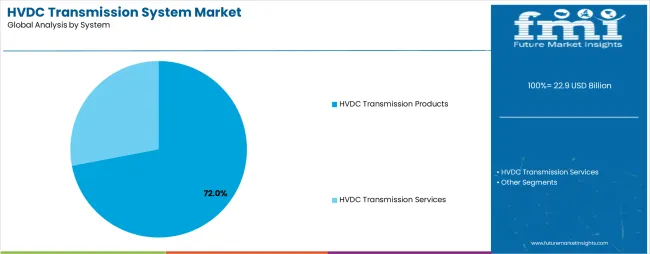
The HVDC transmission products segment is projected to account for 72% of the HVDC transmission system market in 2025, reaffirming its position as the leading system category. Energy utilities increasingly utilize HVDC transmission products for their superior power transfer efficiency, reduced transmission losses, and reliability in long-distance power transmission applications across grid interconnection, renewable energy integration, and bulk power delivery. HVDC product technology's advanced converter capabilities and consistent performance output directly address the utility requirements for efficient power transmission and operational reliability in large-scale energy infrastructure projects.
This system segment forms the foundation of modern power transmission operations, as it represents the infrastructure with the greatest versatility and established market demand across multiple energy applications and grid modernization projects. Utility investments in enhanced converter technologies and deployment systems continue to strengthen adoption among energy companies. With utilities prioritizing transmission efficiency and grid stability, HVDC transmission products align with both operational performance objectives and energy security requirements, making them the central component of comprehensive power transmission strategies.
Energy transmission & distribution is projected to represent 49% of HVDC system demand in 2025, underscoring its critical role as the primary industrial application of HVDC transmission infrastructure for long-distance power transfer and grid connectivity. Power transmission companies prefer HVDC systems for their efficiency, reduced losses, and ability to enhance grid reliability while supporting renewable energy integration and cross-border power trading. Positioned as essential infrastructure for modern power systems, HVDC systems offer both technical advantages and operational benefits.
The segment is supported by continuous innovation in transmission infrastructure development and the growing availability of specialized converter technologies that enable efficient power transfer with enhanced grid stability. Energy utilities are investing in transmission modernization to support large-scale renewable energy integration and grid interconnection. As power demand becomes more prevalent and transmission efficiency requirements increase, energy transmission & distribution will continue to dominate the application market while supporting advanced infrastructure utilization and grid modernization strategies.
The HVDC transmission system market is advancing rapidly due to increasing utility demand for efficient power transmission and growing adoption of renewable energy integration infrastructure that provides reduced losses and enhanced grid stability across diverse transmission applications. The market faces challenges, including high converter station costs, technical complexity in AC grid integration, and the need for specialized installation expertise. Innovation in voltage source converter technologies and digital monitoring solutions continues to influence system development and market expansion patterns.
The growing integration of offshore wind farms and solar energy installations is enabling energy utilities to deploy HVDC systems that provide efficient power transmission with superior loss reduction, enhanced grid stability, and reliable long-distance power transfer capabilities. Advanced HVDC systems provide improved transmission efficiency while allowing more effective renewable energy integration and consistent power delivery across various energy applications and grid interconnection projects. Utilities are increasingly recognizing the competitive advantages of HVDC transmission capabilities for renewable energy connectivity and grid modernization positioning.
Modern HVDC system providers are incorporating voltage source converter technologies and digital twin monitoring systems to enhance transmission efficiency, optimize power quality, and ensure consistent performance delivery to grid operators. These technologies improve operational reliability while enabling new applications, including cross-border interconnections and offshore transmission solutions. Advanced technology integration also allows utilities to support premium grid positioning and energy security beyond traditional transmission infrastructure supply.
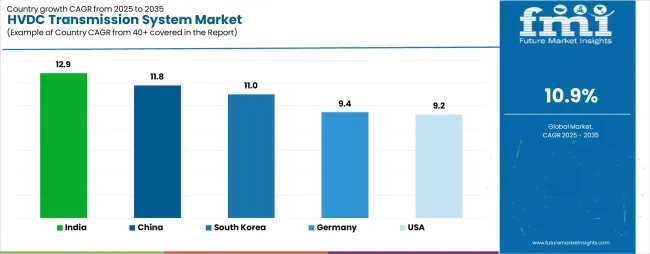
| Country | CAGR (2025-2035) |
|---|---|
| India | 12.9% |
| China | 11.8% |
| South Korea | 11% |
| Germany | 9.4% |
| United States | 9.2% |
The HVDC transmission system market is experiencing strong growth globally, with India leading at a 12.9% CAGR through 2035, driven by the expanding renewable energy integration, growing grid modernization initiatives, and significant investment in transmission infrastructure development. China follows at 11.8%, supported by large-scale UHVDC projects, extensive renewable energy deployment, and growing cross-border power trading. South Korea shows growth at 11%, emphasizing grid interconnection and energy security. Germany records 9.4%, focusing on renewable energy integration and grid modernization. The United States demonstrates 9.2% growth, supported by grid modernization and renewable energy connectivity.
The report covers an in-depth analysis of 40+ countries, the top-performing countries are highlighted below.
Revenue from HVDC transmission systems in India is projected to exhibit exceptional growth with a CAGR of 12.9% through 2035, driven by expanding renewable energy infrastructure and rapidly growing transmission modernization supported by government energy transition initiatives. The country's ambitious renewable energy targets and increasing investment in grid infrastructure are creating substantial demand for advanced HVDC transmission solutions. Major energy utilities and transmission companies are establishing comprehensive HVDC capabilities to serve both domestic grid connectivity and renewable energy integration.
Revenue from HVDC transmission systems in China is expanding at a CAGR of 11.8%, supported by the country's extensive UHVDC project development, advanced transmission infrastructure, and increasing renewable energy integration requirements. The country's comprehensive energy strategy and growing power transmission industry are driving demand for sophisticated HVDC capabilities. State utilities and transmission companies are establishing extensive HVDC infrastructure to address the growing demand for efficient power transmission and grid interconnection.
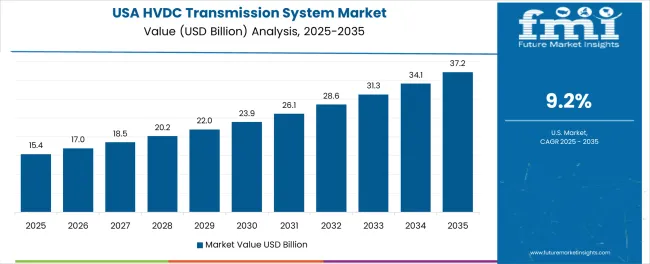
Revenue from HVDC transmission systems in the USA is expanding at a CAGR of 9.2%, supported by the country's grid modernization initiatives, strong emphasis on renewable energy integration, and robust investment in transmission infrastructure among energy utilities. The nation's mature power sector and increasing renewable energy deployment are driving sophisticated HVDC capabilities throughout the transmission network. Leading utilities and transmission companies are investing extensively in grid modernization and advanced transmission infrastructure to serve both domestic energy needs and renewable integration requirements.
Revenue from HVDC transmission systems in Germany is growing at a CAGR of 9.4%, driven by expanding renewable energy integration, increasing offshore wind development, and growing investment in transmission infrastructure modernization. The country's energy transition strategy and advanced grid infrastructure are supporting demand for specialized HVDC technologies across major transmission corridors. Transmission operators and energy utilities are establishing comprehensive capabilities to serve both domestic renewable integration and European grid interconnection markets.
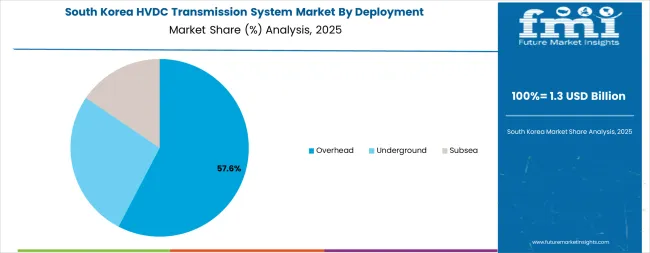
Revenue from HVDC transmission systems in South Korea is expanding at a CAGR of 11%, supported by the country's focus on grid modernization, energy security initiatives, and strategic investment in transmission infrastructure development. South Korea's advanced energy planning and emphasis on grid reliability are driving demand for specialized HVDC technologies focusing on interconnection capabilities and system stability. Energy utilities are investing in comprehensive transmission infrastructure to serve both domestic energy security and potential regional grid connectivity.
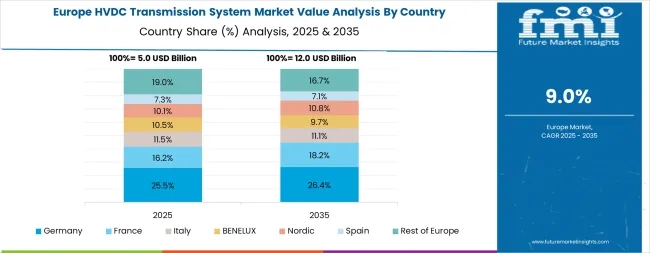
The HVDC transmission system market in Europe is projected to grow from USD 5.2 billion in 2025 to USD 14.6 billion by 2035, registering a CAGR of 10.9% over the forecast period. Germany is expected to maintain its leadership position with a 28% market share in 2025, increasing to 29% by 2035, supported by its strong offshore wind development, advanced transmission infrastructure, and comprehensive grid modernization serving major European interconnection projects.
Norway follows with a 16% share in 2025, projected to reach 17% by 2035, driven by robust hydroelectric power export capabilities, extensive subsea transmission infrastructure, and established North Sea interconnection projects, combined with strong renewable energy export strategies. The United Kingdom holds a 15% share in 2025, expected to maintain 15% by 2035, supported by offshore wind development and grid interconnection requirements but facing challenges from infrastructure investment needs and regulatory complexity. France commands a 12% share in 2025, projected to reach 12.5% by 2035, while Netherlands accounts for 10% in 2025, expected to reach 10.2% by 2035. Denmark maintains a 6% share in 2025, growing to 6.5% by 2035. The Rest of Europe region, including Sweden, Italy, Belgium, Spain, and other European markets, is anticipated to gain momentum, expanding its collective share from 13% to 9.8% by 2035, attributed to increasing renewable energy integration across Nordic countries and growing transmission infrastructure development across various European markets implementing interconnection programs.
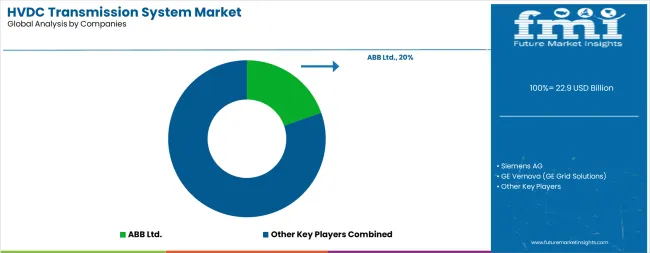
The HVDC transmission system market is characterized by competition among established transmission equipment manufacturers, specialized converter technology providers, and integrated power system companies. Companies are investing in advanced converter technology research, deployment optimization, system reliability enhancement, and comprehensive transmission portfolios to deliver efficient, reliable, and cost-effective HVDC transmission solutions. Innovation in voltage source converter processes, digital monitoring technologies, and subsea deployment capabilities is central to strengthening market position and competitive advantage.
Siemens AG leads the market with a strong market share, offering comprehensive HVDC transmission solutions with a focus on grid interconnection applications and renewable energy integration. GE Vernova provides specialized power transmission capabilities with an emphasis on advanced converter technologies and system integration. Hitachi Energy Ltd. delivers innovative transmission infrastructure solutions with a focus on reliability and operational efficiency. ABB Ltd. specializes in HVDC converter stations and transmission systems for utility markets. Prysmian SpA focuses on transmission cables and integrated infrastructure solutions. Mitsubishi Electric Corporation offers specialized HVDC systems with emphasis on Asian markets and industrial applications.
| Items | Values |
|---|---|
| Quantitative Units (2025) | USD 22.9 billion |
| System | HVDC Transmission Products, HVDC Transmission Services |
| Deployment | Overhead, Underground, Subsea |
| Application | Energy Transmission & Distribution, Grid Interconnection, Bulk Power Delivery, Infeed Urban Areas |
| Regions Covered | North America, Latin America, Western Europe, Eastern Europe, East Asia, South Asia & Pacific, Middle East & Africa |
| Countries Covered | United States, Japan, Germany, India, United Kingdom, France, Italy, Brazil, Canada, South Korea, Australia, Spain, Netherlands, Saudi Arabia, Switzerland and 40+ countries |
| Key Companies Profiled | Siemens AG, GE Vernova, Hitachi Energy Ltd., ABB Ltd., Prysmian SpA, and Mitsubishi Electric Corporation |
| Additional Attributes | Dollar sales by system and application category, regional demand trends, competitive landscape, technological advancements in converter systems, deployment innovation, renewable integration development, and transmission optimization |
The global HVDC transmission system market is estimated to be valued at USD 22.9 billion in 2025.
The market size for the HVDC transmission system market is projected to reach USD 64.4 billion by 2035.
The HVDC transmission system market is expected to grow at a 10.9% CAGR between 2025 and 2035.
The key product types in HVDC transmission system market are HVDC transmission products and HVDC transmission services.
In terms of deployment, overhead segment to command 55.0% share in the HVDC transmission system market in 2025.






Full Research Suite comprises of:
Market outlook & trends analysis
Interviews & case studies
Strategic recommendations
Vendor profiles & capabilities analysis
5-year forecasts
8 regions and 60+ country-level data splits
Market segment data splits
12 months of continuous data updates
DELIVERED AS:
PDF EXCEL ONLINE
USA HVDC Transmission Systems Market Insights – Size, Growth & Forecast 2025-2035
Japan HVDC Transmission System Market - Industry Trends & Forecast 2025 to 2035
Korea HVDC Transmission System Market Trends & Forecast 2025 to 2035
India HVDC Transmission Systems Market Trends – Growth & Demand 2025-2035
Australia HVDC Transmission Systems Market Analysis – Size, Share & Trends 2025-2035
Western Europe HVDC Transmission System Market – Growth & Forecast 2025 to 2035
HVDC Converter Market Size and Share Forecast Outlook 2025 to 2035
HVDC Cables Market Size and Share Forecast Outlook 2025 to 2035
High Voltage Direct Current (HVDC) Capacitor Market Size and Share Forecast Outlook 2025 to 2035
Transmission Overload Protectors Market Size and Share Forecast Outlook 2025 to 2035
Transmission Substation Market Size and Share Forecast Outlook 2025 to 2035
Transmission Oil Filters Market Size and Share Forecast Outlook 2025 to 2035
Transmission Components Market Size and Share Forecast Outlook 2025 to 2035
Transmission Towers Market Size and Share Forecast Outlook 2025 to 2035
Transmission & Distribution Electric Capacitor Market Size and Share Forecast Outlook 2025 to 2035
Transmission Fluids Market Trends & Demand 2025 to 2035
Transmission Sales Market Analysis & Forecast by Type, End Use Through 2035
Transmission Mounting Bracket Market
Transmission Oil Pump Market
Transmission Control Unit Market

Thank you!
You will receive an email from our Business Development Manager. Please be sure to check your SPAM/JUNK folder too.
Chat With
MaRIA